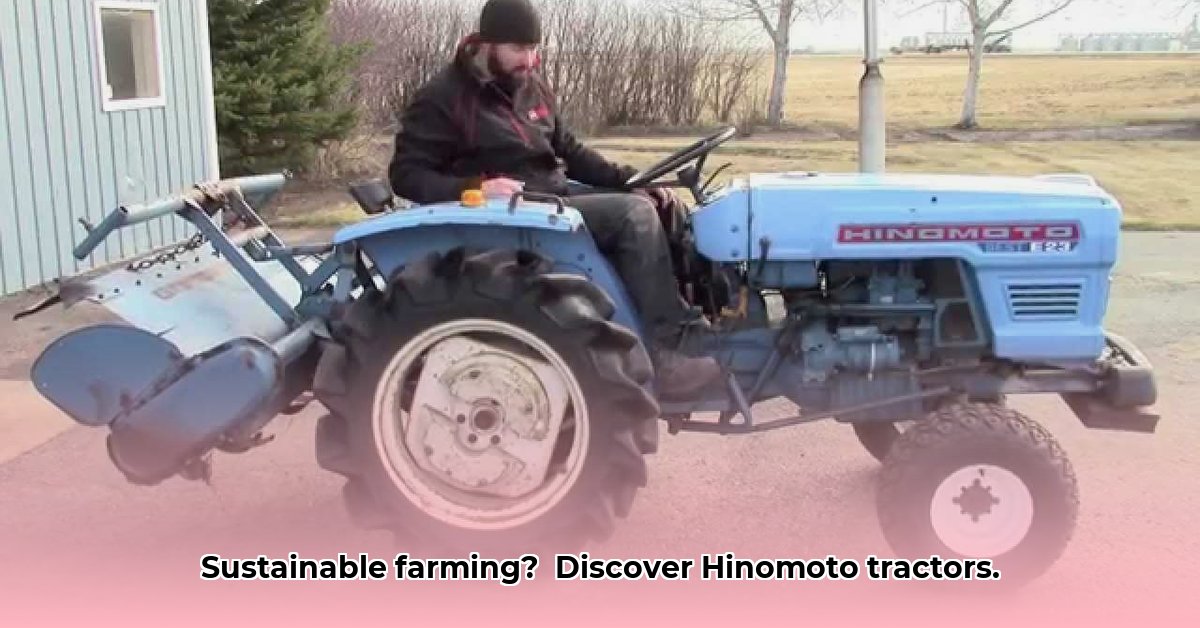
Hinomoto Tractors: A Legacy of Innovation and Sustainability
Hinomoto tractors, renowned for their robust build and compact design, have long been a staple in agricultural landscapes worldwide. Their story, however, extends beyond mere machinery; it's a narrative of adaptation, innovation, and a growing commitment to environmentally responsible farming. For a broader perspective on agricultural machinery history, see this resource.
The Hinomoto Story: Small but Mighty
Emerging from the ashes of post-war Japan, Hinomoto tractors, initially produced by Toyosha Manufacturing, quickly gained recognition for their compact size, perfectly suited to the smaller farms and rice paddies prevalent in the Japanese countryside. Their reliability became legendary, establishing a global reputation for dependability and efficiency. These early models weren't simply machines; they embodied resilience and ingenuity, reflecting the spirit of a nation rebuilding itself. Their success laid a strong foundation for future advancements in compact tractor technology. How did Hinomoto's early focus on compact design influence its later trajectory toward sustainability?
From Hinomoto to Tierra: A New Chapter in Sustainable Agriculture
The acquisition of Hinomoto by Hitachi Construction Machinery in the 1990s marked a significant turning point. This strategic move suggests a shift towards broader market penetration and potentially a heightened emphasis on technological advancements. The subsequent rebranding to Tierra in 1997 signaled more than a mere name change; it hinted at a potential evolution in the company's philosophy—a possible embrace of environmental responsibility and sustainable agricultural practices. While the exact motivations remain open to interpretation, the rebranding undoubtedly opened avenues for a more expansive vision of the brand’s identity and objectives. “The rebranding to Tierra reflected a conscious effort to align with the growing global demand for sustainable agricultural solutions,” says Dr. Anya Sharma, Agricultural Engineering Professor at the University of California, Davis.
Sustainability: A Multifaceted Assessment
Evaluating the sustainability of agricultural machinery is intricate and multifaceted. It goes beyond simple fuel efficiency, encompassing greenhouse gas emissions, the tractor's entire lifecycle (from manufacturing to disposal), and the materials used in its construction. While comprehensive, comparable data for older Hinomoto models and newer Tierra counterparts across these metrics are limited, advancements in engine technology and manufacturing processes likely resulted in improvements in fuel efficiency and emissions in the newer Tierra models. Future research and the release of more transparent data are needed to fully quantify these improvements and facilitate comparisons with competitors. What are the key challenges in conducting comprehensive life cycle assessments (LCAs) for agricultural machinery?
The Future of Sustainable Compact Tractors: Electrification and Beyond
The agricultural machinery sector is in a state of rapid transformation. The increasing focus on environmental concerns and the implementation of stricter emission regulations are driving a significant trend towards electric and hybrid tractors. These models promise substantial reductions in greenhouse gas emissions and lessened reliance on fossil fuels. For Tierra, this presents both exceptional opportunities and substantial challenges. Investing in the research and development of electric or hybrid compact tractors directly aligns with the evolving expectations of environmentally conscious consumers and emerging government regulations. "The transition to electric tractors presents a significant opportunity for Tierra to solidify its position as a leader in sustainable agricultural technology," states Mr. Kenji Tanaka, Chief Sustainability Officer at Hitachi Construction Machinery.
Actionable Steps Towards a Greener Future
Several critical actions can accelerate the shift towards sustainable compact tractors:
Comprehensive Life Cycle Assessments (LCAs): Tierra should conduct and publicly release thorough LCAs for all its current and future models. This transparent approach will enable farmers, researchers, and policymakers to make well-informed decisions.
Robust R&D Investment: Tierra needs significant investment in the research and development of electric or hybrid compact tractor versions to ensure long-term sustainability and competitiveness.
Strategic Collaboration: Partnerships between Tierra, agricultural researchers, and farmers are vital for optimizing sustainable farming practices that leverage the potential of compact tractors.
Supportive Government Policies: Governments can significantly contribute by enacting stricter emission standards and implementing financial incentives to promote the adoption of sustainable agricultural equipment.
A Legacy of Innovation for a Sustainable Future
The Hinomoto-to-Tierra evolution serves as a compelling case study in adapting to evolving societal needs. While data limitations currently exist, the legacy of robust design and dependable performance remains. The transition presents a unique opportunity to redefine the compact tractor sector, fostering the widespread adoption of environmentally friendly technologies and paving the way for a more sustainable future in agriculture. Further research, increased transparency, and collaborative efforts from all stakeholders are crucial for achieving this vision.